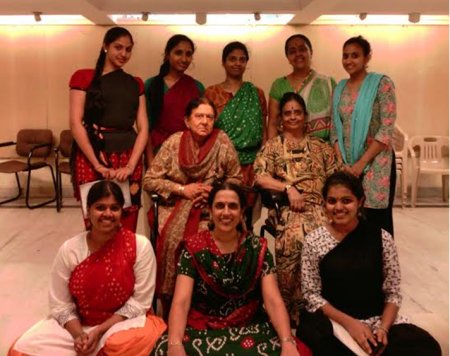
|   |

|   |
A workshop on rare composition from Mysore Sampradaya - Padmini Shreedhar e-mail: bramhi503@gmail.com January 23, 2015 A classical dance workshop was organized by Bharatiya Vidya Bhavan in association with Mysore Sampradaya dance experts Dr. Lalitha Srinivasan and Dr. Padma Sampath (USA). An American by birth, Nala Najan had spent 14 long years in post -independent India learning Bharatanatyam both in Mysore and Thanjavur, seats of learning dance and music in that era. He had maintained a detailed diary, documented dances he had learnt meticulously which has been preserved to every possible detail by his foremost disciple, Dr. Padma Sampath. The records are undiluted and authentic in all aspects. The dances are undoubtedly examples of the guru-shishya parampara, oral tradition which has stood the test of time in the Indian context.  One selected dance piece, Bhairavi varnam, written by one of the Tanjore Quartet was taught in the workshop. Padma earnestly shared the nuances of the varnam as taught to her by her guru. This varnam showcases the artistic exchange programs between kings of those days reassuring their friendship and appreciation. The story behind this varnam goes like this. The Mysore Wodeyars requested their visiting court poet/scholar (one of the Tanjore brothers) to compose a special composition in praise of the Maratha kings and commissioned it through a court dancer, who in turn travelled to the Thanjavur court and performed the composition with all élan and success, boosting the ego and morale of the Thanjavur kings. Each and every line of the pallavi of the varnam has an elaborate storytelling sequence, the sancharis enhancing the vaakyartha and the baahaavartha abhinaya. The rhythmic passages in-between are crisp and short. The syllables used for the rhythmic patterns are simple and melodious. The dance steps are very typical to Mysore sampradaya with curvilinear movements and grace. The most striking feature of the varnam is that it tells the spectator the glory and grandeur of the erstwhile Maratha kings Tulajendra and his son Sharabhendra of the 19th century who ruled Thanjavur and nearby places. Their flamboyant lifestyles, the vast, fertile and geographical borders of their land, the temples they patronised are understood in utmost detail through this musical composition. The ten-day workshop (Dec 14 - 24, 2014) proved to be a good learning experience. The group of dancers learnt with earnest enthusiasm. The way of life of yesteryears’ royalty along with dance nuances were shared and discussed with sincere interest during the workshop. Another interesting feature of the workshop worth sharing was that we practiced to the music which was studio-recorded in the 1960s for Nala Najan by his teachers Mugur Sundaramma and Nanjanagudu Nagarathnamma, in which the former renders the vocals and the latter wields the cymbals. One more noteworthy feature, the saxophone, which was the wind instrument used for Bharatanatyam performances in those days, is also part of the music ensemble heard on the cassette. Mugur Sundaramma and Nagarathnamma were accomplished disciples of Jetti Thayamma and also belonged to the ancestral roots of Nanjanagudu tradition. The Bharatiya Vidya Bhavan, Bangalore, hosted this event which proved to be an eye-opener to today’s dance practitioners in realizing the rich classical dance heritage of Karnataka. The young dance aspirants were in awe when Padma Sampath explained the glory of those days, narrating interesting anecdotes which she had heard from her Guru Nala Najan. The copies of the original manuscripts given to us as notes will surely help us to keep the tradition alive and we thank Padma Sampath for her generous sharing of knowledge. Under the workshop series in the year 2013, Padma had shared three dance numbers -a rare javali on Madana, the god of love; a padam and a Pushpanjali /Thodayam. Padmini Shreedhar is a dance research scholar. |